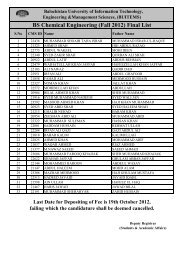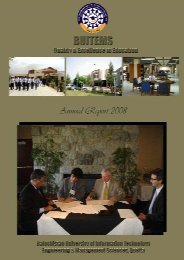BUITEMS
Research Journal - buitems
Research Journal - buitems
- No tags were found...
Create successful ePaper yourself
Turn your PDF publications into a flip-book with our unique Google optimized e-Paper software.
<strong>BUITEMS</strong><br />
Quality & Excellence in Education<br />
Introducing Lane Based Sectoring for Routing in VANETs<br />
E[x] is the average number of time slots for a<br />
successful transmission and E[t] is the average<br />
length of a time slot; σ is the duration of empty<br />
slot, Ts and Tc is the average time the medium<br />
is sensed busy because of a successful<br />
transmission or a collision respectively.<br />
Ts = DIF S + tr + δ + ACK (10)<br />
T c = DIF S + t r + timeout + δ (11)<br />
In case of lane based sectoring method,<br />
the rebroadcast delay E [ D ] is strictly<br />
dependent on the density of nodes. Rush<br />
hour traffic has the lowest rebroadcast delay<br />
as the smaller back off value cells, like all<br />
other cells, are likely to be occupied, thus<br />
causing rebroadcast in the first few time<br />
slots of the contention window. Therefore,<br />
in rush hour traffic for lane based sectoring<br />
method, as Ptr becomes equal to c ,<br />
and CN approaches zero, the probability<br />
of successful transmission Ps approaches<br />
nearly 1.<br />
Simulation Analysis<br />
Simulation setup<br />
To analyze the comparison of normal<br />
sectoring broadcast and lane based<br />
sectoring broadcast, the general broadcast<br />
procedure followed by UMB, SB and IB in<br />
(Korkmaz et al., 2004, Fasolo et al., 2006,<br />
Khan et al., 2011) was fully implemented<br />
using both normal sectoring as well as lane<br />
based sectoring in ns-3 simulator, version<br />
3.9. The traffic mobility is generated using the<br />
tool VanetMobiSim (Haeri et al., 2006).<br />
Simulation parameters are summarized in<br />
Table 1. We have used 1 km road length<br />
scenario with unidirectional road having four<br />
and eight lanes. Fifteen different vehicle<br />
densities are tested with density ranging from<br />
2 to 30 nodes per lane per 300 meters length<br />
of the road (i.e. one hop distance), and having<br />
Gaussian randomly assigned speeds with<br />
mean 50 miles/h and standard deviation 3<br />
miles/h. The minimum headway between<br />
vehicles is kept as 10 meters to account for<br />
worst case scenarios. Jakes model has been<br />
used to estimate Rayleigh fading for the<br />
channel (Blaszczyszyn et al., 2009). To best<br />
study the performance of the proposed<br />
technique, the scenario is tested for different<br />
message generation rates of 0.01 to 1<br />
message per vehicle per second.<br />
Table I SIMULATION PARAMETERS<br />
Figure 2. Rebroadcast delay in 4 and 8 lanes,<br />
average collision percentage; (message size 300<br />
bytes).<br />
RESULTS AND DISCUSSION<br />
Fig. 2(a) and 2(b) show average rebroadcast delay<br />
in 4 and 8 lane road configuration with variable<br />
vehicle densities. NB in the figure denotes<br />
83
















